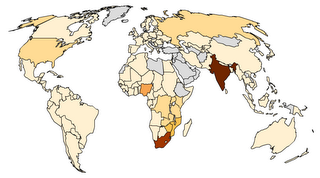 "AIDS 2006," the XVI International AIDS Conference organized by the International AIDS Society, began here in Toronto, Canada, last night. It's a serious conference, of course, but the power of celebrity cannot be denied. And so, among the speakers are Bill Clinton, Bill Gates and Richard Gere. (Aside: Guess which one hasn't had his private parts discussed in public?)
"AIDS 2006," the XVI International AIDS Conference organized by the International AIDS Society, began here in Toronto, Canada, last night. It's a serious conference, of course, but the power of celebrity cannot be denied. And so, among the speakers are Bill Clinton, Bill Gates and Richard Gere. (Aside: Guess which one hasn't had his private parts discussed in public?)Digital coverage is available via Kaisernetwork.org, Clinical Care Options and, of course, the blogosphere. To appreciate the extent of the problem that is HIV/AIDS, take a look at the UNAIDS 2006 Report on the global AIDS epidemic. There is also a map on Globalhealthfacts.org that shows the number of people living with HIV/AIDS worldwide.
Globalhealthreporting.org has a map and a table that puts data for HIV/AIDS, tuberculosis and malaria side-by-side. Pointing your mouse at the Philippines on the map shows that HIV/AIDS is not as big a problem in my home country as tuberculosis and malaria. Clicking on the Philippines will lead to a page on Globalhealthfacts.org that provides the numbers, additional information and sources.
The Philippine National AIDS Council has some useful information and downloadable files, including Republic Act No. 8504 (pdf), but it is the Remedios AIDS Foundation, with its graphs and tables (as of April 2006), that is more helpful for those looking for statistics. The AIDS Society of the Philippines is practically useless because it was last updated in 2004!
The most famous AIDS victims in the Philippines were Dolzura Cortez and Sarah Jane Salazar, primarily because movies were made about their lives. Both are now dead. Read "Health care personnel's critique on the Philippines' first movie on AIDS" by S.B. Zaldivar (AIDS Care, 1 February 1995) to see what Filipinos learned from the movie about Dolzura Cortez. See also the abstract of "Bridging the gaps in HIV/AIDS education through films" by N.P. Simbulan, a conference paper presented in 2000.
Finally, there's "Exploring the realities of HIV/AIDS-related discrimination in Manila, Philippines" by N.L. Ortega, et al. (AIDS Care, July 2005), which only confirms what many Filipinos already know: the existence of a law does not and cannot eradicate discrimination by itself.
Categories: Events, The Philippines
Globalhealthreporting.org has a map and a table that puts data for HIV/AIDS, tuberculosis and malaria side-by-side. Pointing your mouse at the Philippines on the map shows that HIV/AIDS is not as big a problem in my home country as tuberculosis and malaria. Clicking on the Philippines will lead to a page on Globalhealthfacts.org that provides the numbers, additional information and sources.
The Philippine National AIDS Council has some useful information and downloadable files, including Republic Act No. 8504 (pdf), but it is the Remedios AIDS Foundation, with its graphs and tables (as of April 2006), that is more helpful for those looking for statistics. The AIDS Society of the Philippines is practically useless because it was last updated in 2004!
The most famous AIDS victims in the Philippines were Dolzura Cortez and Sarah Jane Salazar, primarily because movies were made about their lives. Both are now dead. Read "Health care personnel's critique on the Philippines' first movie on AIDS" by S.B. Zaldivar (AIDS Care, 1 February 1995) to see what Filipinos learned from the movie about Dolzura Cortez. See also the abstract of "Bridging the gaps in HIV/AIDS education through films" by N.P. Simbulan, a conference paper presented in 2000.
Finally, there's "Exploring the realities of HIV/AIDS-related discrimination in Manila, Philippines" by N.L. Ortega, et al. (AIDS Care, July 2005), which only confirms what many Filipinos already know: the existence of a law does not and cannot eradicate discrimination by itself.
Categories: Events, The Philippines

